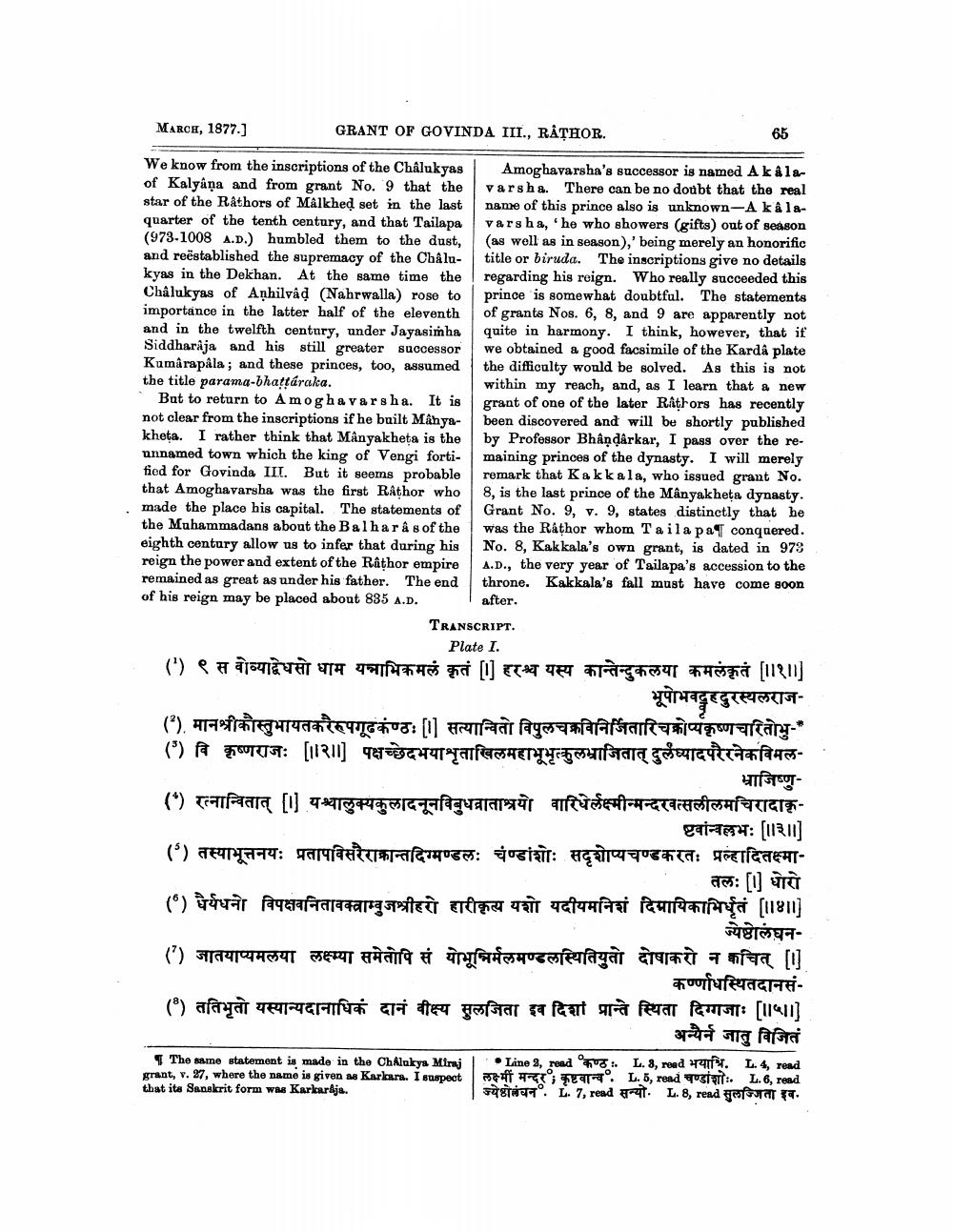________________
MARCH, 1877.]
We know from the inscriptions of the Chalukyas of Kalyana and from grant No. 9 that the star of the Râthors of Målkhed set in the last quarter of the tenth century, and that Tailapa (973-1008 A.D.) humbled them to the dust, and reestablished the supremacy of the Châlukyas in the Dekhan. At the same time the Chalukyas of Anhilvâd (Nahrwalla) rose to importance in the latter half of the eleventh and in the twelfth century, under Jayasimha Siddharaja and his still greater successor Kumarapala; and these princes, too, assumed the title parama-bhattaraica.
But to return to Amoghavarsha. It is not clear from the inscriptions if he built Mânyakheta. I rather think that Mânyakheta is the unnamed town which the king of Vengi fortified for Govinda III. But it seems probable that Amoghavarsha was the first Râthor who made the place his capital. The statements of the Muhammadans about the Balharâs of the eighth century allow us to infer that during his reign the power and extent of the Râțhor empire remained as great as under his father. The end of his reign may be placed about 835 A.D.
GRANT OF GOVINDA III., RATHOR.
65
The same statement is made in the Chalukya Miraj grant, v. 27, where the name is given as Karkara. I suspect that its Sanskrit form was Karkardja.
Amoghavarsha's successor is named A kalavarsha. There can be no doubt that the real name of this prince also is unknown-A kalavarsha, 'he who showers (gifts) out of season (as well as in season),' being merely an honorific title or biruda. The inscriptions give no details regarding his reign. Who really succeeded this prince is somewhat doubtful. The statements of grants Nos. 6, 8, and 9 are apparently not quite in harmony. I think, however, that if we obtained a good facsimile of the Kardâ plate the difficulty would be solved. As this is not within my reach, and, as I learn that a new grant of one of the later Rathors has recently been discovered and will be shortly published by Professor Bhandarkar, I pass over the remaining princes of the dynasty. I will merely remark that Kakkala, who issued grant No. 8, is the last prince of the Mányakheta dynasty. Grant No. 9, v. 9, states distinctly that he was the Rathor whom Taila pa¶T conquered. No. 8, Kakkala's own grant, is dated in 979 A.D., the very year of Tailapa's accession to the throne. Kakkala's fall must have come soon after.
TRANSCRIPT. Plate I.
(') ९ स वोव्याद्वेधसो धाम यन्त्राभिकमलं कृतं [1] हरश्य यस्य कान्तेन्दुकलया कमलंकृतं [||१||] भूषेोभवदृहदुरस्थलराज
(2) मानश्री कौस्तुभायतकरेरुपगूढकंण्ठः [1] सत्यान्वितो विपुलचकविनिर्जितारिचको व्यंकृष्णचरितो भु-" (*) विकृष्णराजः [ ||२|| ] पक्षच्छेदभवा भृताखिलमहाभूभृत्कुलश्राजितात् दुलंप्यादपरेरनेकविमलभ्राजिष्णु(*) रत्नान्वितात् [1] चालुक्यकुलादनूनविबुधवातात्रय बारिधेर्लक्ष्मीन्मन्दरवत्सलीलमचिरादाकृएवान्वलभः [||३||] ( ं) तस्याभूत्तनयः प्रतापविसरैराक्रान्तदिग्मण्डल: चंण्डांशोः सदृशोप्यचण्डकरतः प्रल्हादित क्ष्मातल: [1] धोरो (i) धैर्यधनो विपक्षवनितावक्त्राम्बुजश्रीहरो हारीकृत्य यशो यदीयमनिशं दिनायिकाभिर्धृतं [ || ४ || ] ज्येष्ठोलंघन - () जातयाप्यमलया लक्ष्म्या समेतोपि सं योभूनिर्मलमण्डलस्थितियुतो दोषाकरो न कचित् [1] कर्णास्थितदानसं(8) ततिभृतो यस्यान्यदानाधिकं दानं वीक्ष्य सुलजिता इव दिशां प्रान्ते स्थिता दिग्गजाः [ ||५॥] अन्येन जातु विजितं
• Line 2, rond कण्ठ:. L. 8, read भयाभि. L. 4, rend लक्ष्मीं मन्दर कृष्टवान्व L. 5, read चण्डांशो:. L. 6, rend ज्येष्ठोलंघन. 1. 7, read सन्यो L. 8, read सुलज्जिता इब.




